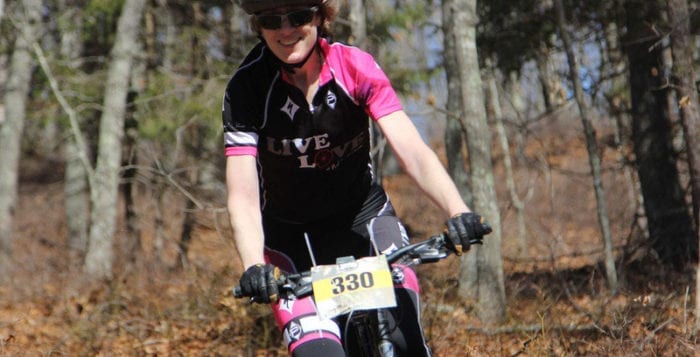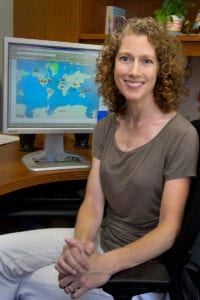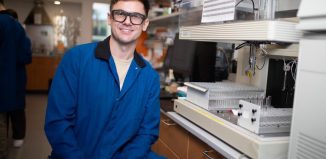BNL’s Cialella a ‘consensus builder’ in environmental science

Researchers at Brookhaven National Laboratory have traveled the world, placed their scientific instruments aboard commercial ships, or gathered information from satellites, aircraft and ground-based facilities to study the atmosphere, the environment and the weather.
Chemist Arthur Sedlacek, whose work was featured last week in the Times Beacon Record, has journeyed in a plane above wildfires in the western United States to collect information about aerosolized particles, while atmospheric scientist Ernie Lewis has gathered data from commercial ships that trek back and forth from Los Angeles to Hawaii to determine how clouds change along the route through the Pacific.
Assistant ecologist Shawn Serbin, meanwhile, has studied the spectroscopic properties of forests to determine how an area responds to different temperature, precipitation and atmospheric conditions.
These are all part of the mission of the Environmental and Climate Sciences Department at BNL, explained Alice Cialella, the interim chair of the department and also the manager of the DOE ARM Climate Research Facility External Data Center.
The Environmental and Climate Sciences Department, which includes over 50 scientific, professional and technical staff, is also engaging in several new efforts, including a collaboration with Stony Brook University. Using several mobile radar systems donated by companies and the military, these two local institutions will gather a wealth of data about the local and regional climate and environment.
“The unprecedented array of radars will help us better understand pre-storm conditions before high impact weather events, provide detailed wind data for modeling energy and pollution flow through cities and better process level understanding of precipitation and cloud formation,” Cialella explained in an email.
To be sure, the initiative is so new that the weather satellites, which can be loaded on a truck and moved to different parts of a city, haven’t arrived yet. “There are many more details to work out,” she said.
This is just one of several initiatives that are all a part of the DOE-funded facility’s efforts to gain a better understanding of the local and global environment and how it might be changing over time.
Recently, Cialella’s department participated in a study to look at how air particles circulate through New York City subway stations for the Department of Homeland Security. Separately, atmospheric scientist Andrew Vogelmann is collaborating with a multi-institution study to connect ARM Climate Research Facility’s observations to climate modeling efforts.

Cialella, who has served as the interim chair of the department for six months, said this effort will “create more synergy between weather observational data sets and climate modelers.”
Martin Schoonen, the associate laboratory director for the Environment, Biology, Nuclear Science and Nonproliferation Directorate at BNL, said he chose her as interim chair because “she has proven to be a very effective group leader, growing her group significantly over the last few years and taking on a leadership role within the DOE-Atmospheric Radiation Measurement and Climate Research Facility.”
Schoonen called her a “consensus builder” who “listens well to people and takes time to get to know all perspectives.” Cialella is “absolutely” in contention for the full-time role in the Environmental and Climate Sciences Department, Schoonen said.
Cialella said she sees opportunities to encourage scientific partnerships. “I look for a high level understanding of the science and try to identify common themes that aren’t being fully utilized or appreciated,” she said. The department is in two buildings and she tries to ensure that she assists with any potential collaborations among researchers in the same department but at different locations.
Serbin said he appreciates how Cialella has encouraged collaborations among researchers who study different elements of the environment.
Hired at first for her software engineering skills and her master’s degree in physical geography, one of her initial jobs was to create maps for the ARM sites using Geographic Information Systems software.
In her work as the manager of the data center, which represents about half her time, Cialella and Laurie Gregory supervise a team of eight. They identify new sources of data that are external to the ARM Climate Research Facility and that augment the ARM facility, such as weather forecast model data. The group has been creating ARM databases and Web data applications for ARM for over 20 years.
While she hasn’t worked on a computer program in a number of years, Cialella’s work allows her to engage in “more broad-thinking and strategic planning.” Over time, the focus of the ARM Climate Research Facility has shifted from gathering information through observations to using that information to inform global climate models. “In the last couple of years, the move has been to provide the data for the modeling component of the program much more directly,” she said.
A resident of Poquott, Cialella lives with her husband John Robinson, who is a professor in integrative neuroscience in the Department of Psychology at Stony Brook. Using mouse models, Robinson hopes to understand the function and dysfunction of the human central nervous system.
The couple has a daughter Zoe, who is a senior at Ward Melville High School and is planning to attend the University of Vermont in the fall.
Cialella said she enjoys anything that gets her moving. She runs, bikes, swims and does triathlons in the summer. Exercise is a great “stress reliever,” she said. She also enjoys being a part of a book group. She recently read “Tinkers” by Paul Harding.
Cialella grew up in Maryland, the fourth of five children. Her late father, Carmen, was a physicist at Aberdeen Proving Grounds.
As for her work, Cialella said she continues to plan for the future. “You always want to be thinking at least three to five years out and what the next area of research might be,” she said. “The next area may well be high-resolution atmospheric modeling for urban and regional studies.”






